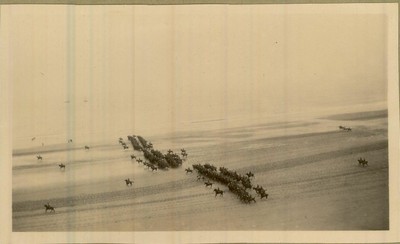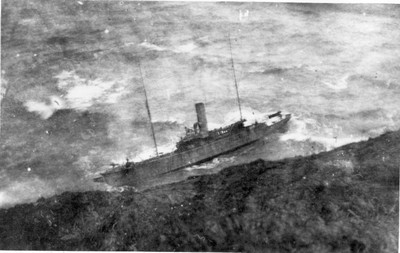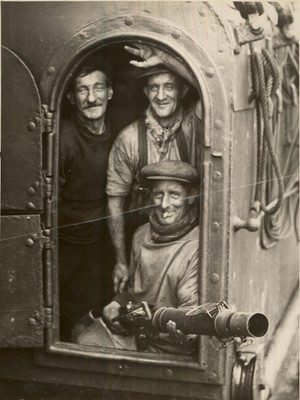
Menu:
Filey at War
Filey and its
fishing community have had a long relationship with the military. In
addition to local men who had enlisted in the Army and most usually
the Royal Navy, the local area had been used as a training ground
from at least the formation of the Territorial Army in 1908. At the
outbreak of the Great War in August 1914 Filey quickly became a
garrison town and after the bombardment of Scarborough in December
the whole coast was to be seen as a point of weakness for a
threatened invasion. Two major units were stationed at Filey for the
whole of the war, firstly The Huntingdonshire Cyclists and after March
1917 The Manchester Regiment Reserve Battalions. The Archive holds
what is thought to be the most complete collection of the monthly
regimental journal of this regiment, and these have been scanned
to allow the public to view every page of every issue.

East Riding Yeomanry Filey Beach July 1915 Copyright © Crimlisk - Fisher Archive
During the course of the conflict some 500 Filey men, regulars, volunteers and conscripts alike were to serve in the armed services. Almost 20% of those men were to perish in the unabated carnage that befell Europe for four and a half years. Seventy-one names are remembered on the town memorial, but many others with connections to Filey also fell in the conflict.
Those who remained also found themselves in the front line as many fishing boats were required to serve as minesweepers. Due to the clean air and climate Filey also had at least one VAD hospital for the injured during the Great War.
The lifeboat crew also served in war as they did in peacetime, rescuing many from the sea. In March 1916 a steam yacht serving as a coastal patrol, the SS Mekong ran onto the rocks at Gristhorpe in heavy weather. The Filey Rocket Brigade set out to locate the wreck, but in the meantime two of the crew had tried to swim ashore with a line. Their efforts failed, and their bodies were found on the rocks later. The all but one of the remaining crew members were rescued alive by the Rocket Brigade who hauled them up the cliffs in a breeches buoy. The wreck of the Mekong lay forgotten until 1960 when it was reported that many live shells were spilling from it. Naval divers were called in and the wreck was blown up with only the vessel's crest remaining intact, now held by the Crimlisk Fisher Archive.

The wreck of the Mekong 1916. Copyright © Crimlisk - Fisher Archive
The Town erected a
War memorial in 1921 to the men who had fallen, but many with close
connections to Filey are not listed. Filey's greatest single war
related tragedy was to happen five months after the end of the
conflict when “The Emulator” struck a mine with the loss of all
seven crew.

East Riding Yeomanry Filey Beach July 1915 Copyright © Crimlisk - Fisher Archive
During the course of the conflict some 500 Filey men, regulars, volunteers and conscripts alike were to serve in the armed services. Almost 20% of those men were to perish in the unabated carnage that befell Europe for four and a half years. Seventy-one names are remembered on the town memorial, but many others with connections to Filey also fell in the conflict.
Those who remained also found themselves in the front line as many fishing boats were required to serve as minesweepers. Due to the clean air and climate Filey also had at least one VAD hospital for the injured during the Great War.
The lifeboat crew also served in war as they did in peacetime, rescuing many from the sea. In March 1916 a steam yacht serving as a coastal patrol, the SS Mekong ran onto the rocks at Gristhorpe in heavy weather. The Filey Rocket Brigade set out to locate the wreck, but in the meantime two of the crew had tried to swim ashore with a line. Their efforts failed, and their bodies were found on the rocks later. The all but one of the remaining crew members were rescued alive by the Rocket Brigade who hauled them up the cliffs in a breeches buoy. The wreck of the Mekong lay forgotten until 1960 when it was reported that many live shells were spilling from it. Naval divers were called in and the wreck was blown up with only the vessel's crest remaining intact, now held by the Crimlisk Fisher Archive.

The wreck of the Mekong 1916. Copyright © Crimlisk - Fisher Archive
Europe was again to throw the World into chaos with the outbreak of the Second World War with the unprovoked attack by Nazi Germany on Poland. War was declared on 3rd September 1939 and raged across the continent and the world for nearly six years.
Once again Filey men were to serve and die and the town became in the forefront of coastal defence. Filey also hosted a large number of evacuees, in particular children from Hull schools. The men who stayed at their occupation in the vital fishing industry were to see action through the war with some fishing boats armed by the war department, as well as mine-sweeping duties.

Some of the crew of the "Silver LIne" who brought down a Heinkel in 1940. Copyright © Crimlisk - Fisher Archive
The lifeboat was also often called on to rescue both mariners and aircrew who had found themselves at the mercy of the North Sea.
The Archive holds many images, records and artefacts from both of the great conflicts of the Twentieth century and these are available for researchers and the public to view.
For a fascinating account of Filey's place in the Great War 1914-18 click here (downloads a .pdf document)
© Crimlisk - Fisher Archive. Written for the web by B Mulrine based on research by The Filey Bay Initiative and D Eaton.